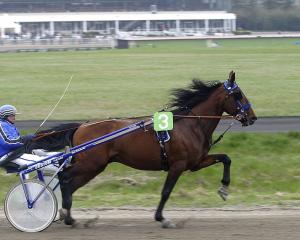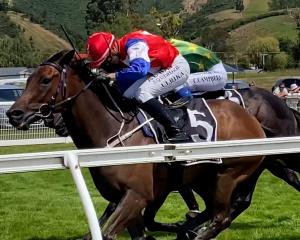Tayler Strong has resigned as racing editor of the Otago Daily Times after 37 years in the job. He looks back over his time in the role.
Horse racing is a specialised field with a good deal of family involvement.
• Tributes to Tayler Strong
I have been dealing with three generations of some of the families.
I became keen on horse racing through attending meetings at Forbury Park with family acquaintances.
Horses have always been the attraction, as well as the people in the business. The people give the horses a lot of care and attention, and value them highly.
My interest was extended when I left school in 1961 and worked for my uncle, Charlie Dillon, who employed a private trainer, Syd Kemble, on his farm at Kaweku in Southland.
I went back to school the following year to complete the University Entrance exam, with a view to attending Lincoln College and studying for a degree in agriculture. I was due to return there in 1964 when I spotted a job advertisement for an assistant to the racing editor at the Southland Times. I applied and began work under Norman Pierce in March 1964.
In March 1967, I joined the Otago Daily Times as a racing reporter. In April 1968, I became racing editor of the Timaru Herald. Finally, in September 1975, I succeeded Jack Morris as racing editor of the ODT.
I have always been reluctant to compare horses from different eras, but I rate Cardigan Bay as the best horse I have seen racing. Cardigan Bay was the first standardbred in the world to earn $1 million in stakes. He won the 1963 New Zealand Cup from a 54yd (49m) handicap, and an Auckland Cup from 78yd (71m). Colossal efforts.
Show Gate, trained at Mosgiel Park by owner Gordon Thomson, remains top of the list among the thoroughbreds. I was at the New Zealand Cup meeting in 1974 when she won the Stewards' Handicap (1200m), Canterbury Gold Cup (2000m) and Churchill Stakes (1600m) in successive starts over eight days. That is versatility unequalled at the top level.
Lyell Creek has been the standout among the straight-out trotters with his 56 wins worldwide and $2.9 million in stakes. He won 15 group one races and 20 races in a row.
Bonecrusher provided one of my greatest memories when he won the White Robe Lodge Handicap at Wingatui in 1988.
Bonecrusher displayed his champion qualities to win by a head from Robinski in his first race for 10 months.
Bonecrusher had provided one of the great race finishes of all time when winning the 1986 W S Cox Plate at Moonee Valley by a neck after a titanic struggle with Waverley Star.
I was in Auckland in 1975 to see Young Quinn make a clean sweep of the Interdominion series over three heats and a final.
Ron Bisman, of the Auckland Star, had been instrumental in arranging that trip. I began contributing to the Trotting Annual, edited by Ron, in 1973.
I established a poll among journalists for Harness Horse of the Year in 1974 and this was published in the annual for several years. The poll was subsequently taken over by Harness Racing New Zealand.
Ron and I co-authored The Interdominions, first published in 1975, with a fourth enlarged edition in 1986.
The book included the deeds of many of the prominent horsemen I had encountered.
Maurice Holmes, the leading reinsman for 18 seasons, and Ces Donald, the first trainer, either standardbred or thoroughbred, to prepare 1000 winners in New Zealand, were among them.
I also wrote of Rex Cochrane, the first thoroughbred trainer to reach the 1000 in 1980, and John Dowling, the first apprentice to win the national jockeys' premiership in 1964.
Dowling was based at Wingatui, where the Anderton family figured prominently among my notes. Hector Anderton was three times the leading New Zealand trainer, and his son, Brian, established the White Robe Lodge Stud and stood leading sires Mellay and Noble Bijou. He continues to train successfully.
Ted Winsloe, of Gore, shared the top honour with Hector Anderton in 1963-64. I was in Gore in October 1964 when Winsloe trained seven winners on the nine-race card.
Bill Hillis, of Riverton, was a prominent trainer and rider of jumpers in the same era. He was twice the leading New Zealand trainer in the 1960s, a remarkable feat as private trainer to Bill Hazlett, of Invercargill.
I remember writing a piece on leading jockey Bob Skelton when he rode his 1000th winner, Red Sash, in Invercargill in January 1968.
The Didhams were another prominent Wingatui racing family in my racing notes.
Jockey "Midge" Didham rode Baghdad Note to win the 1970 Melbourne Cup for Dunedin owner Stuart Falconer and Wingatui trainer Bob Heasley.
As well as writing, I have enjoyed photographing racing.
I was encouraged into photography in 1976 by Tom Lloyd, then illustrations editor of the ODT. Some of my racing photographs have won national awards.
I consider I am fortunate my employer has left me largely to my own devices to do the job over the past 37 years. I have had the support of many people in racing and newspapers, and I am thankful for that.
Bruce Fraser, the racing sub-editor at the ODT, has worked alongside me for those 37 years.
Bruce knows and corrects the words I spell wrongly, or the horse names that cause me confusion.
The role of racing editor at the ODT has been dis-established. A new racing-sports reporting role has been created, but I have decided not to apply for it.
I want to step back, allow the dust to settle and decide if I will retire or continue with some sort of work. I did have an ambition to complete 50 years in journalism which would mean another 14 months in the sphere.
Horse racing is a specialised field with a good deal of family involvement. I have been dealing with three generations of some of the families.
Over the years, I have gone to great lengths to keep readers informed of racing matters. It's been an enjoyable and rewarding career.

















